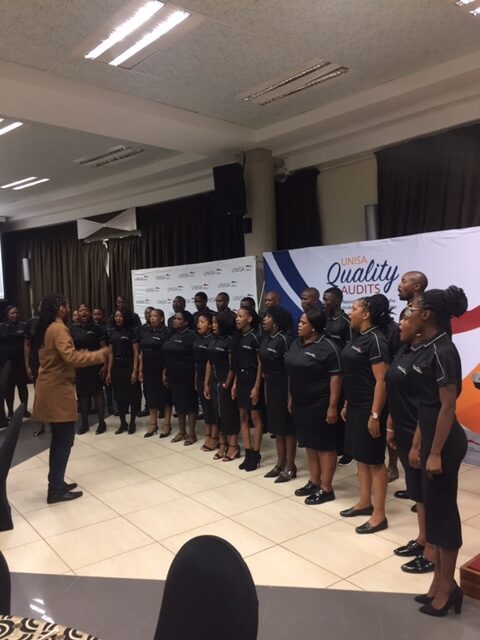Last summer I was asked to join a “quality audit” team that had been created by the Commonwealth of Learning and contracted by the University of South Africa (UNISA) to do a Trail Audit. This process involved a trip to London and this month a trip to Petoria, SA. In this post I talk about UNISA, about my experiences (to which I am not accustomed) in business class and a brief encounter with the South African medial system.
The University of South Africa
The first thing you might notice from the picture below and when driving into Petoria from Johannesburg airport, is the imposing campus of the UNISA. This is the main campus in Petoria which is augmented by a network of regional offices and campuses spread throughout the country. Unisa boast over 340,000 students making it the largest university in the Southern hemisphere. All of the undergraduates work from home, businesses or regional offices. Thus, the campus houses faculty, a huge printing press, library and offices for graduate students – of which there are also thousands.
 The University will be audited in 2020 by the Council on Higher Education (CHE) which is the accreditation and regularity agency of the Government of South Africa. In preparation for this Quality audit, the University contracted with COL to undertake a pre-trial quality audit.
The University will be audited in 2020 by the Council on Higher Education (CHE) which is the accreditation and regularity agency of the Government of South Africa. In preparation for this Quality audit, the University contracted with COL to undertake a pre-trial quality audit.

UNISA Choir entertains
Unisa was the first university in South Africa from which all of the other universities spun off. Unisa was established by the Brits in 1873 after the University of London model in which no teaching is does, but they set curriculum and examine students who learn however they can. Nelson Mandela is their most famous grad. In 1947 the University started creating print packages, thus becoming the worlds’ first distance eduction institution. They have begun huge (34% of all postsecondary students in South Africa) and largest university in Africa. They are struggling to move from an Open and Distance Learning (ODL) university to an Open and Distance Electronic Learning (ODeL) university – with a zillion challenges. One of which is figuring out if they should abandon their printing presses (largest print shop in the southern hemisphere). The print shop has a warehouse sized “Vault” in which they guard the final exams, since they are terrified of ”leaks” , by which Mafia types obtain final exams and sell them a few days before the exams are written – all across the country on the same exam days. They have testing centres in Johannesburg that sit 2,000 students, at a time, 3 sessions a day. This places them – like most higher education institutions very vulnerable to academic fraud.
Our 6 person team was led by the President of COL and consisted of Professors from South Africa, Tanzania, India, Mauritius and Canada. and with interest in quality standards, technology, student support, African universities and African Open Universities. During the week of our visit we interviewed about 300 people – from President to many students, on main campus and 5 regional centres. The idea of hiring a group of outsiders to audit a whole Universities quality standards just doesn’t happen in Canada, so I really didn’t know what to expect. A really striking feature of the project was the posters, banners, meals, banquets and pomp and circumstances about this audit and our visit . Quite surprising to see notes on our arrival displayed all over the campuses we visited.

Gala Goodbye banquet with Jazz Quartet
The University (and the 5 particular programs that we selected for detailed review) undertook a self-evaluation (300 + pages of text) before our arrival. On the final afternoon we provided our initial findings to a cast of a few hundred. This presentation focused on areas lsuch as quality assurance measures, teaching and learning (my area), technology used, research capability etc. etc. Our report seemed to be well received – but how much credibility can you give to a self evaluation and 5 day visit by group of outsiders? Now we go home and pour through the notes from 2 scribes hired to record everything and then create (and have them verify) a final report. The report will have both commendations (what we impressed by) and recommendations (suggestions for improvement).
Adventures in Business Class.
Last March I had Speaking trip to South Africa as an invited keynote speaker at UNISA’s annual research week. Thus, I was well aware of the challenges of 23 hours in the air and another 10 so getting to, and switching airports. Thus, the offer to repeat the journey this month- but in business class was a real incentive. I got to savour the service on three different airlines (Westjet, KLM and Virgin Air). The trip from Edmonton in December involves travelling through two nights. Of course they treat business class passengers with a lot more choice and comfort than I’m used to in coach. I relaxed and actually fell asleep in 3 types of “sleeping pods”. The biggest surprise was opening the duffle bag at my seat on Virgin Air, thinking it would be the too small blanket that I would wrestle myself under. But no! It was a pair of flannel pyjamas – Like I am going to get into pyjamas and walk down the aisle – NOT!
The food was great – they even had a standup bar with snacks on the 747! But I didn’t do much but read, NOT drink too much, watch a couple of good movies and then sleep! I arrived at 11:00 PM Sunday and we had our first meeting at 7:30 AM the next day, so I didn’t have any time for jet lag. Getting a good sleep on the airplane seems to have almost eliminated jet lag – at least on this trip for me!

Now getting to the hard part – the carbon footprint. You may have read the data that the extra carbon cost of business class and I don’t doubt it is true. So I have little excuse, except to hope that our recommendations will impact the lives of 340,000 students at UNISA. And that that will make a difference.
My Encounter with South Africa and It’s Health Care System
South Africa is (at least by Canadian standards) a pretty scary place. Very visible poverty and unemployment are clearly visible. The protection industry is thriving guards (mostly unarmed), barbed wire, police cars and groups of people in the streets are everywhere. Alongside the poverty are miles of gated and fenced (and I mean big fences) communities. Thus there are many living in pretty severe poverty, while the evolving middle class (both whites and blacks) lives at least partially in a culture of fear. The scary irony is that the country (with its opportunities!) attracts thousands of economic refugees daily from other African countries.
I also had an adventure with the South African medical system. Two days after my arrival I started getting a pain in my lower leg, this continued into a purple rash that kept growing. I figured I better get it checked in case it was flesh eating disease or something worse! UNISA staff took me to the University Health clinic where the nurse suggested I should see a doctor. The clinic referred me to a hospital, but my hosts figured it would be too long of a wait so we travelled way into the burbs to a health clinic where I had an appointment with two doctors. It was weird entering the strip mall clinic (open 24 hours a day) and seeing signs in both Africans and English and staff of all races – expect the doctors that I saw were both white.
They pretty quickly diagnosed the rash as shingles, but they also did all kinds of pressing and pushing, blood test, heart stuff etc. I walked out with 3 prescriptions and a bill for about $100 Canadian total. Ironically, I had had a shingles c=vaccine four years ago, but I have come understand the chicken pox/shingles virus (they are the same critter) can erupt at any time from those who have chicken pox in their lifetime. I didn’t really understand the contagion issue with shingles at the time and so thought it best to cancel my one-day safari trip to see the lions. Fortunately it rained anyways, but we were told that when it rains when visitors come, it is a very good omen!
So South Africa seems to have a great health care system – IF you have money. This clinic was nearby the gated community where the black vice president who was hosting us lived, so we dropped him off at his home. He had a card to open the gate and let us drive into his house, but when we went to leave, the guards wouldn’t let me and the black driver out!! We had to drive back to the VP’s house and get him to verify that we hadn’t ransacked his house.
My flight home was uneventful- the best kind.
I hope you have enjoyed this brief chronicle of the trip.
Hi Terry,
I was searching for a few bits and pieces of UNISA’s history when I stumbled upon your blog. South Africa seems to have made quite an impression on you. Right? Was this your first time here? Your interpretation of what you saw is spot on to a large extent.
In South Africa, fear is encoded in the architecture, buildings, landscapes and may social spaces. Even though we pay taxes as if we were in Canada (I attended UofA and taught a little at Athabasca, soI consider myself an Edmontonian of sorts, a fan of Oilers and Eskimos), we still need to give away an arm and a leg for security to ease our fear, which is never enough. Here you must have eyes on your back. Three weeks ago, my wife was taking our little girls to school when a young man smashed the front-door window on the passager seat and stole her phone. We had additional, unexpected expenses, for a new phone, a new window, and a smash-and-grab protective layer on the car windows.
Before UofA (2004/2009), I attended UNISA in the 1990s, and it always gives me some perspective to hear someone else’s take on South Africa and UNISA. UNISA is indeed facing enormous challenges. While the in the 1990s it was rare to hear of exam leaks, these days it is widespread. Just this past December, UNISA had to annul an exam which was stolen and leaked several days before. A UNISA spokesman was tongue-twisting on the radio the other day trying to explain to spin the issue. UNISA, however, is an indispensable asset in this continent and the school is a good position to catapult Africa to Open, Distance and Electronic Education.
Tell me, are the Oilers winning?
David